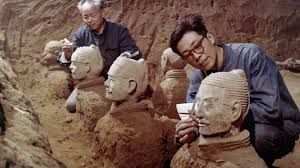
The Discovery of the Terracotta Army
A Chance Encounter
The Terracotta Army, one of the most significant archaeological discoveries of the 20th century, was unearthed entirely by accident. On March 29, 1974, a group of farmers in the Lintong District, near Xi'an, China, were digging a well in preparation for the dry season. As they dug deeper, their tools struck something hard and unforgiving. It wasn't the water table they had anticipated but fragments of terracotta, baked clay. These shards, as they would soon discover, belonged to the first of thousands of life-sized terracotta warriors, silently standing guard over a vast underground empire for over two millennia.
Intrigued and somewhat alarmed by their find, the farmers contacted the local authorities. Archaeologists were dispatched to the site and immediately recognized the significance of the discovery. They had stumbled upon the easternmost pit of the sprawling mausoleum complex of Qin Shi Huang, the first emperor of a unified China.
Unearthing an Army
The initial discovery triggered an extensive excavation project that continues to this day. Archaeologists have since unearthed four main pits, each serving a distinct purpose within the grand scheme of the emperor's afterlife. Pit 1, the largest, contains the main force of the Terracotta Army, an awe-inspiring sight of over 6,000 life-sized warriors, chariots, and horses, all meticulously arranged in battle formation.
Standing at an average height of six feet and weighing approximately 600 pounds each, these terracotta figures are not mere replicas but unique individuals, each with its own distinct facial features, hairstyle, armor, and posture, reflecting the real-life army that had once unified China. They were armed with real weapons, including bronze swords, spears, and crossbows, many still sharp and deadly after centuries buried underground.
Beyond the Ranks
While the sheer scale of the army is undoubtedly impressive, the attention to detail and craftsmanship are what truly set the Terracotta Army apart. Every wrinkle on a soldier's brow, every fold in their garments, speaks volumes about the skill and artistry of the Qin dynasty craftspeople.
Beyond the ranks of infantry, cavalry, and charioteers, archaeologists also uncovered terracotta figures of entertainers, acrobats, and officials, suggesting a desire to recreate every aspect of courtly life in the afterlife. The emperor, it seemed, spared no expense in preparing for his journey into eternity.
The Legacy of the Terracotta Army
The discovery of the Terracotta Army sent shockwaves through the archaeological community and captivated the world's imagination. It offered an unprecedented glimpse into the military might, artistry, and funerary practices of ancient China.
Today, the Terracotta Army is a UNESCO World Heritage Site and one of China's most popular tourist destinations. The warriors still stand guard, facing east, the direction from which enemies were expected in the emperor's time, a silent testament to the ambition and ingenuity of one of history's most powerful rulers.
Q&A
1. When and where was the Terracotta Army discovered?
The Terracotta Army was discovered on March 29, 1974, in Lintong District, near Xi'an, China.
2. Who discovered the Terracotta Army?
The Terracotta Army was discovered by a group of farmers who were digging a well.
3. Why was the Terracotta Army built?
The Terracotta Army was built to accompany Qin Shi Huang, the first emperor of a unified China, in his afterlife. The figures were meant to serve as his guardians and symbolize his power and authority even in death.